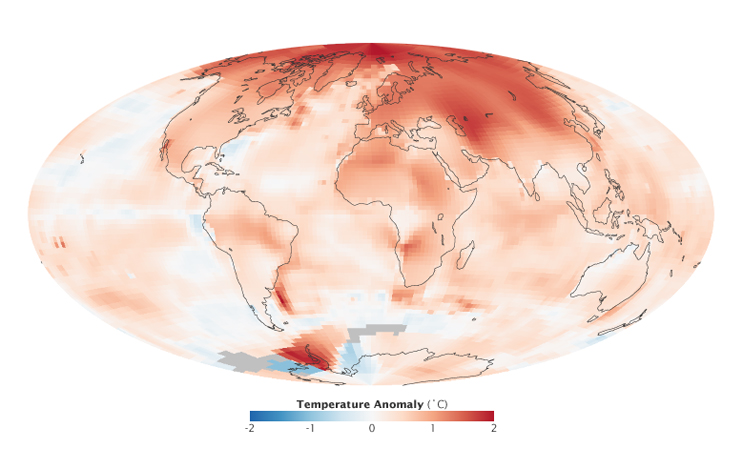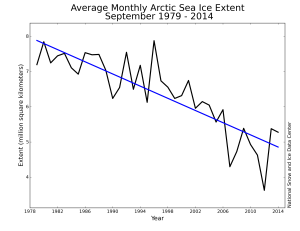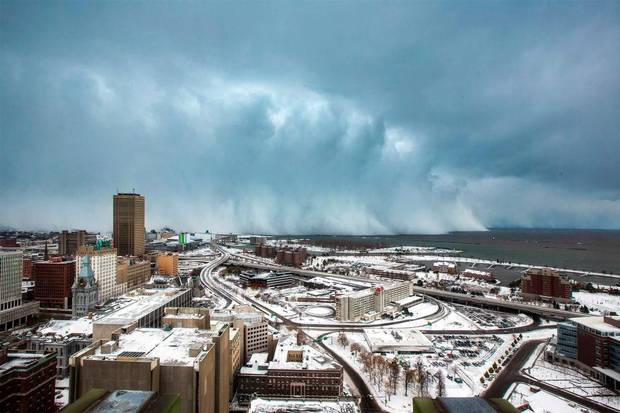“Warming of the climate system is unequivocal, and since the 1950s, many of the observed changes are unprecedented over decades to millennia. The atmosphere and ocean have warmed, the amount of snow and ice have diminished, sea level has risen, and the concentration of greenhouse gases have increased.”

Fig. 1: Global temperature anomalies for 2000 to 2009. The Figure shows how much warmer or colder a region is compared to the norm for that region from 1951 to 1980. Note, that anomalies are largest in the Arctic. Credit: NASA image by Robert Simmon, based on GISS surface temperature analysis data including ship and buoy data from the Hadley Centre.
This statement taken from The Fifth Assessment Report of Climate Change by the International Panel of Climate Change (IPCC, 2013) gives an idea of the changes in the climate system that have been observed in recent decades. Perhaps the most prominent indicator of Climate Change is a positive trend in the global mean surface air temperature of about +0.85°C over the last 130 years (Fig. 1). Further, local trends in precipitation and changes in the number of occurrences of extreme weather, such as heat waves, droughts or extreme precipitation events, have been observed (IPCC, 2013) – all of which have a variety of social and economic consequences. In the Arctic, the most significant sign of climate change is the melting of Arctic sea ice. Since the beginning of continuous satellite observations in 1979, the Arctic sea-ice extent has decreased dramatically. The largest reduction is observed in September, where the ice extent has declined by almost 50% (Fig. 2; Vihma, 2014). These changes can largely be related to the observed temperature rise. Moreover, due to local feedbacks and interactions with the sea ice and snow cover, Arctic temperatures have risen almost double as much as the aforementioned global mean temperature (also referred to as Arctic amplification; see Fig. 1; Serreze and Francis, 2006). But why is there so much interest in the Arctic region, considering that less than 1% of the Earths population actually lives in the Arctic?

Fig. 2: Monthly September ice extent for 1979 to 2014 shows a decline of 13.3% per decade relative to the 1981 to 2010. Credit: National Snow and Ice Data Center.
Besides the importance of sea ice for the Arctic temperature amplification, links to weather and climate have been found (see Vihma 2014). Some local effects – effects observed within the Arctic boundaries – comprise increases in the ocean to atmosphere energy exchange (Screen and Simmonds, 2010) and in evaporation, precipitation and cloud cover, specifically over areas with relatively less sea ice in winter (Alexander et al., 2004; Porter et al., 2004). Further, over areas with a relatively low summer sea-ice extent the surface pressure has been found to be lower than usual (Blüthgen et al., 2012). The latter indicates a linkage between sea ice and atmospheric circulation, such as large-scale circulation patterns or cyclones/storms. Large-scale circulation patterns and storms are the main mechanisms responsible for the heat and moisture exchange between the relatively warm mid-latitudes and the cold Arctic, and thus are not confined to the Arctic region. This relationship raises the question of whether sea-ice changes can have impacts on the weather and climate in areas outside the Arctic boundary. Can some of the aforementioned trends in precipitation or the number of extreme events be explained by the sea-ice loss in the Arctic? A relationship between summer sea-ice extent and atmospheric circulation patterns outside the Arctic has been found by Francis et al. (2009). Liu et al. (2012) established a connection between the frequency of extreme weather events, such as storms and cold and snowy winters in the United States (Fig. 3) and northwestern Europe, and the decline of autumn sea ice. Moreover, Wu et al. (2009) showed a statistical relationship between Arctic spring sea-ice concentration and rainfall in China.

Fig. 3: Snowstorm over Lake Erie in Buffalo, New York, on November 18, 2014. During November 17 and 19, 2014, a cold air outbreak, related to the advection of cold Arctic air masses led to record temperatures and heavy snow fall in large parts of the US. Specifically, the northeast of the US was affected. In the state of New York roads were impassable, schools closed and flights canceled. The West of New York even declared a state of emergency. Picture courtesy: Lindsay Dedario/Reuters.
These studies indicate that there is a relationship between the rapid climate change in the Arctic and the observed variability of mid-latitude weather. This connection is strongly related to changes in the atmospheric circulation, and thus to the energy exchange between the Arctic and mid-latitudes. This link between Arctic and mid-latitudes answers the question: why does the Arctic matter? However, neither the processes explaining the sea-ice decline nor those linking the Arctic and the mid-latitudes are yet fully understood. One of the reasons for this lack in knowledge is the limited availability of data. Observations are sparse, as the cold and harsh conditions make field research difficult and expensive. Further, continuous satellite observations, of for e.g. the sea-ice extent, are only available since 35 years and do not allow for comprehensive statistics – thus findings are not entirely statistically robust. Additionally, most of the current climate models are not able to capture the observed sea-ice trend and specifically not the strong year-to-year variability of the sea-ice cover (see Fig. 2). However, although with certain limitations, these studies highlight the importance of the Arctic and point towards the risks and consequences of a melting Arctic sea-ice cover for the mid-latitudes.
References:
Alexander MA, Bhatt US, Walsh JE, Timlin MS, Miller JS, Scott JD (2004). The atmospheric response to realistic Arctic sea ice anomalies in an AGCM during winter. J Clim 17, 890–905.
Blüthgen J, Gerdes R, Werner M (2012). Atmospheric response to the extreme Arctic sea ice conditions in 2007. Geophys Res Lett 39, L02707.
Francis JA, Chan W, Leathers DJ, Miller JR, Veron DE (2009). Winter Northern Hemisphere weather patterns remember summer Arctic sea-ice extent. Geophys Res Lett 36, L07503.
IPCC, (2013). Climate Change 2013: The Physical Science Basis. Contribution of Working Group I to the Fifth Assessment Report of the Intergovernmental Panel on Climate Change [Stocker, T.F., D. Qin, G.-K. Plattner, M. Tignor, S.K. Allen, J. Boschung, A. Nauels, Y. Xia, V. Bex and P.M. Midgley (eds.)]. Cambridge University Press, Cambridge, United Kingdom and New York, NY, USA, 1535 pp.
Liu J, Curry JA, Wang H, Song M, Horton RM (2012). Impact of declining Arctic sea ice on winter snowfall. Proc Natl Acad Sci USA 109, 4074–4079.
Porter DF, Cassano JJ, Serreze MC (2012). Local and large-scale atmospheric responses to reduced Arctic sea ice and ocean warming in the WRF model. J Geophys Res 117, D11115.
Screen JA and Simmonds I (2010). The central role of diminishing sea ice in recent Arctic temperature amplification. Nature 464, 1334–1337.
Serreze MC and Francis JA (2006). The Arctic on the fast track of change. Weather 61, 65–69.
Vihma T (2014). Effects of Arctic sea ice decline on weather and climate: a review. Surv Geophys 35, 1175-1214.
Wu B, Zhang R, Wang B, D’Arrigo R (2009). On the association between spring Arctic sea ice concentration and Chinese summer rainfall. Geophys Res Lett 36, L09501.







